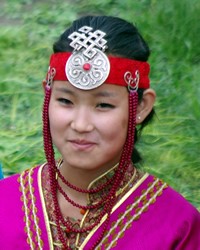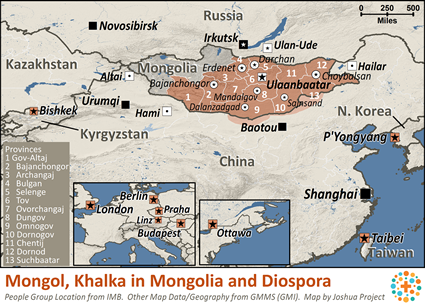The Khalka a are the largest group of Mongols in Mongolia. In fact, they are the core of all the Mongol peoples across North Asia. The Khalka Mongols consider themselves the direct descendants of Genghis Khan, and therefore, the true preservers of Mongol culture.
In the thirteenth century, Genghis Khan formed one of the greatest empires in world history by uniting all of the nomadic Mongol tribes. During the centuries that followed, the once mighty Mongol empire was squeezed between the growing Russian and Chinese empires. In the early 1920s, Mongolia became a Marxist state until its quiet democratic revolution in 1990.
The Khalka Mongols consider their language, Halh, to be the "real" Mongolian language, since all other Mongols speak variations or dialects of Halh. Halh is understood throughout Mongolia and by Mongols living in Central Asia.
Mongolia was once one of the most closed countries in the world but is now relatively open to outside influence.
There is a large population of Khalka Mongol nomads. They live in herding camps and migrate seasonally with their livestock. Their housing takes the form of portable gers, which are round felt tents that have brightly painted wooden doors. The nomads raise horses, cattle, and sheep and migrate four or five times a year in search of fresh pastures.
Some Khalka Mongols are now settled farmers who live and work on collective (community) farms. Those who live in the cities occupy Soviet-built apartment complexes. Many have found jobs in industry, mining or transport.
Due to the harshness of the climate in Mongolia, the Khalka Mongol diet consists primarily of fat, meat (mainly mutton), milk and dairy products. Large amounts of fat and mutton are eaten during the winter, and dairy products such as yogurt, cheese and sour cream are eaten during the summer. Their favorite drink is airag, fermented mare's milk.
Khalka Mongols look to nomadism for their identity, and they have a long tradition of having disdain for urban life. Genghis Khan often tore down cites, leaving them to become pastureland. In today's world, 40 percent of Mongolians live in their one significant city, Ulaanbaatar. Unemployment and drunkenness are major problems there. An excellent ministry would be to start a business that employs a large number of Mongol men and invest in their lives.
Khalka Mongols traditionally married while they were very young. The girls were usually 13 or 14, and the boys were only a few years older. Today, couples usually marry while they are in their early to mid-twenties; then they immediately begin having children. Urban Khalka Mongols, especially those with a college education, tend to delay marriage until they reach their late twenties. Birth control is discouraged in Mongolia. Families with six or more children are given financial benefits.
Khalka Mongols love music, folk dances, chess and sporting events. Every July, the ancient Naadam festival is celebrated throughout Mongolia. Sporting events are held in horse racing, archery and wrestling.
Khalka Mongols were traditionally Shamanists (belief in an unseen world of gods, demons, and spirits). The people depended on shamans (medicine men) to cure the sick by magic, communicate with the gods and control events.
In the late 1500s, the Mongols were introduced to Tibetan Buddhism, and most Mongols converted to Buddhism at that time. By 1900, more than half of Mongolia's males were serving as priests in Buddhist monasteries. However, as a result of an anti-religious movement launched by the Marxist government in the 1930s, about three-quarters of the Khalka Mongols became either non-religious or atheists.
Today, a number of Khalka Mongols have returned to the beliefs of their forefathers. Shamans are once again called upon to cure the sick or alleviate evil spirits through divination, oracles and astrology. A combination of Buddhism and Shamanism has survived, especially among the elderly. Obos, heaps of stones thought to be inhabited by local spirits, can still be seen on almost every hilltop.
Mongolia's distance from the sea and poor roads have contributed to a poor economy. One-third of the country lives in extreme poverty. Rape, murder, alcoholism and violence are major problems in Mongolia's urban areas today. Many young people are also involved in criminal gangs.
Pray that Khalka Mongol men would rise up to become strong in the Lord.
Pray for the Lord to minister to women who have suffered from sexual violence and the results of family alcoholism.
Ask God to set Khalka Mongols free to worship the Lord and discard spiritual traps.
Pray that alcoholism, violence and divorce will be wiped out.
Scripture Prayers for the Mongol, Khalka in Mongolia.
https://en.wikipedia.org/wiki/Khalkha_Mongols
https://www.britannica.com/place/Mongolia/Settlement-patterns
| Profile Source: Joshua Project |


























